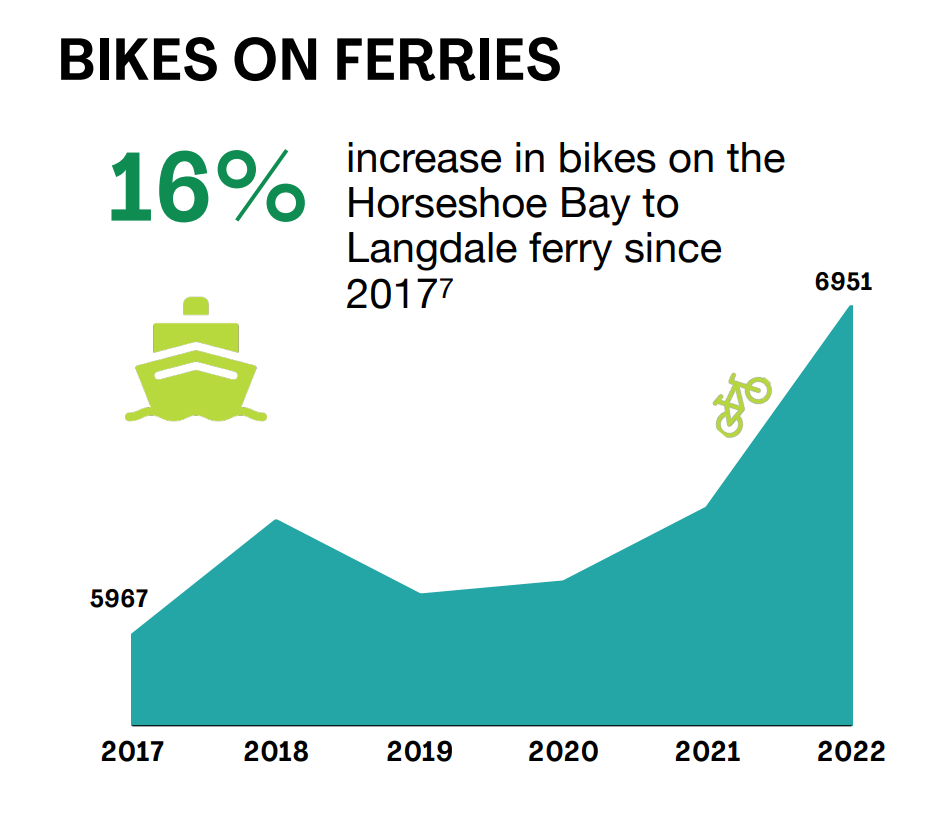Cyclist use of BC Ferries' (BCF) Langdale-Horseshoe Bay route is growing.
That mode of getting to and from the Coast has increased every year since 2019, according to Transportation Choices (TraC) Sunshine Coast’s annual progress report, released Feb. 5. Cyclists using Route 3 rose by 16 per cent between 2017 and 2022, TraC's report highlights, citing statistics provided by the ferry corporation last fall.
Those numbers do not include ferry travellers who haul cycles with their vehicles, then ride once they have made the crossing, TraC board co-chairs Stephen Forgacs and Kylie Hutchinson pointed out in a Feb. 6 interview with Coast Reporter.
Opting to cycle or use alternatives like walking, public transportation or “car-pools” when travelling by ferry reduces the vehicle loading and space demands on sailings, Forgacs said. That leaves time and room to maximize the number of passengers each sailing can carry. To make ferry crossings supplemented by cycle travel as attractive as possible, he said TraC will be reaching out to BCF with suggestions to improve that experience. Those include asks for more cycle racks on the vessels and at terminals.
While BCF’s data did not differentiate between pedal and electric-powered bikes, Forgacs said he has seen a big uptick in the number of e-bikes on Route 3 sailings. TraC would like to see BCF add the capacity for those cyclists to safely charge their rides while making the crossing, better preparing them for road travel once they reach their destination terminal.
Shifting minds and transportation modes
To build the active transportation participation rate among Coast residents and the public in general, Forgacs said, “We need a culture shift and a shift in the way we think about transportation.”
Along with making improvements to cycling infrastructure, like the creation of the “Connecting the Coast” ferry-to-ferry active transportation path, he encourages parents to “model” to their children travelling by alternatives to private motor vehicles. Options like travelling as a family on local transit and being a “walk-on” when using the ferry, are growing in popularity, based on his observations.
“I see young families doing that all the time, and that is helping kids understand that cycling, walking and transit are perfectly viable, convenient means of transportation. We don’t have to go everywhere by car,” said Forgacs.
Another “big win” for active transportation on the Coast has been the local government attention on the issue, said Hutchinson. She noted that the Town of Gibsons, District of Sechelt and Sunshine Coast Regional District all have active transportation plans either in place or in development.
Economic benefits
Hutchinson highlighted that using person-power to move about the community has benefits not only for the health of the people participating but for the health of the local economy. She noted that more than 300 people took part in the “Slow Food Cycle” last fall, travelling by bike then spending on consumables and dining at Gibsons’ area farms and food production sites. TraC was one of that event’s organizers and plans are in the works to host the activity again this year.
For Hutchinson, improving our area’s active transportation infrastructure also encourages residents to patronize local stores, even with the lure of e-commerce popping up on digital device screens everywhere. The ability to make small purchases while avoiding the costs and waits for deliveries and potential hassles with returns are real advantages to shopping locally, she explained. And travelling in a sustainable wait to shop minimizes the carbon footprint of making those purchases, she said.



